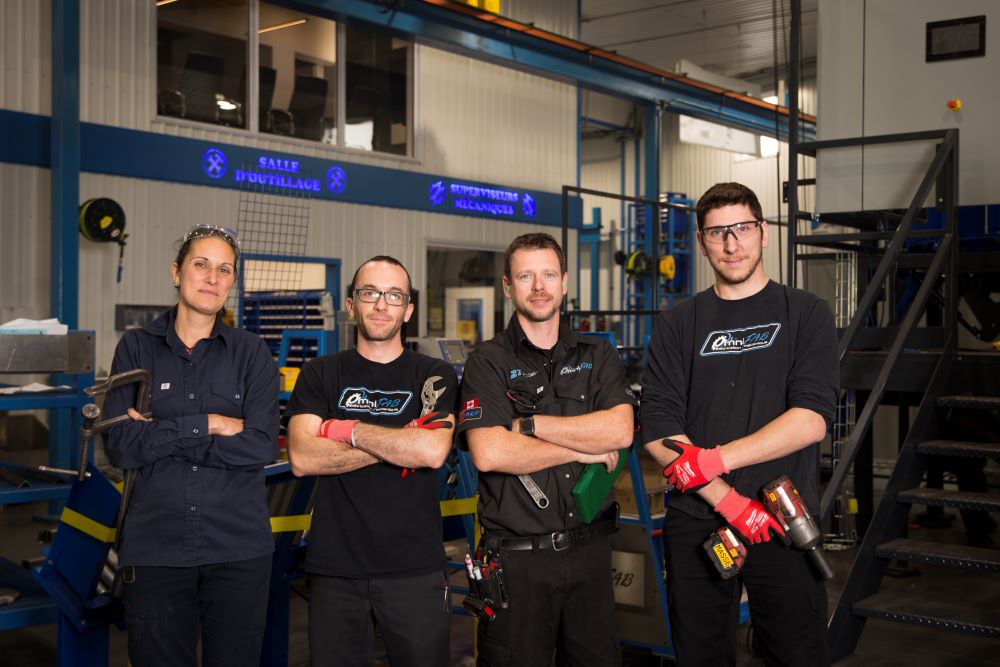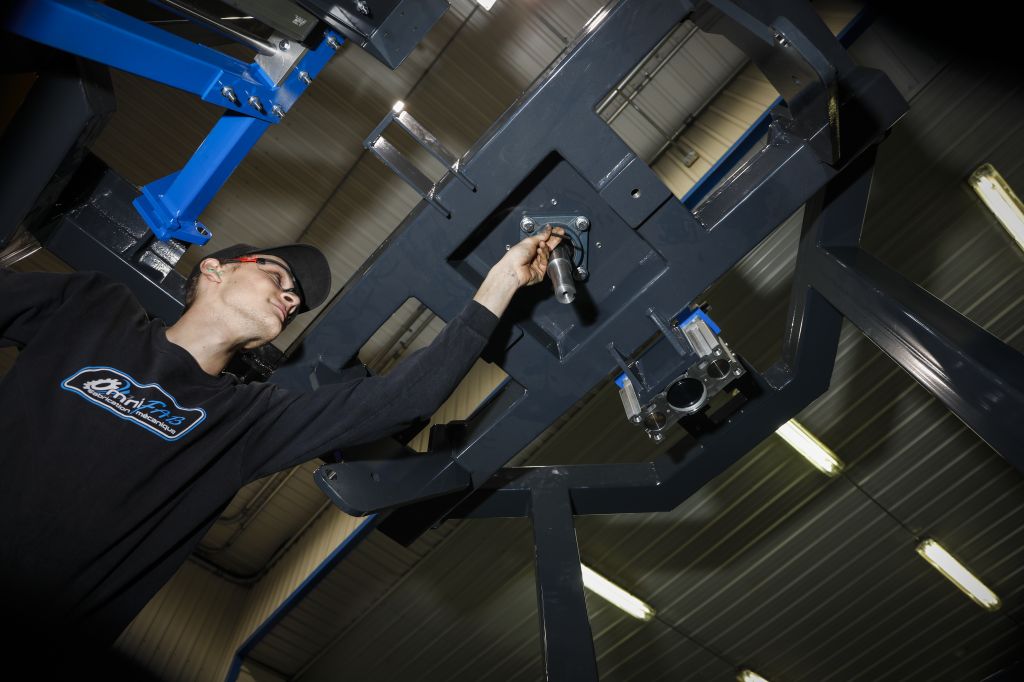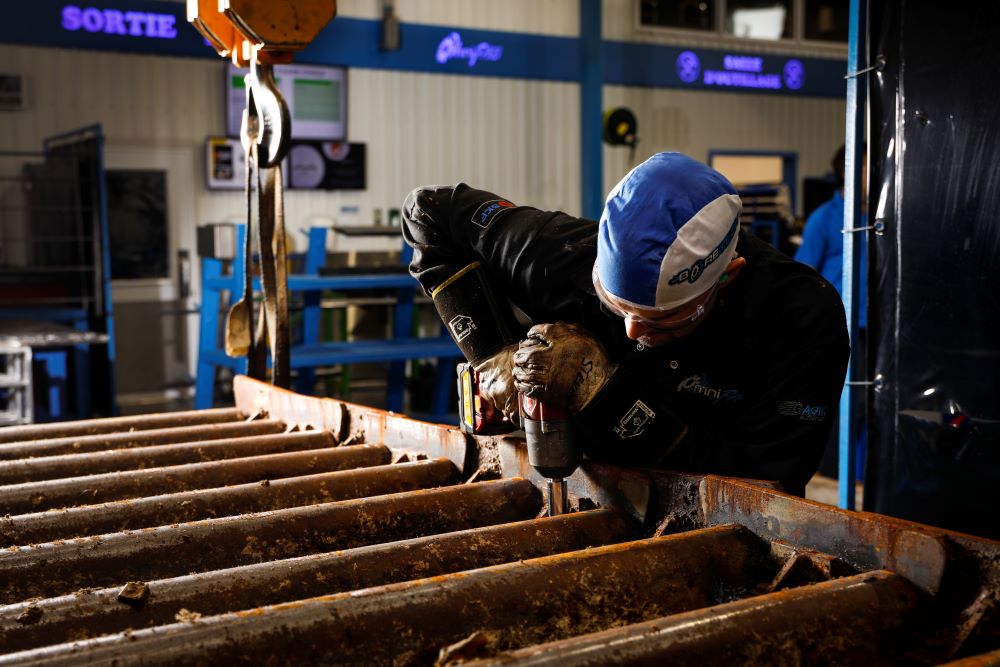Because of their abundance, it would be almost impossible to list all the devices whose operation depends on the use of bearings. In both industry and everyday life, bearings are literally everywhere: production machinery, motorized equipment, power tools, household appliances – the list goes on and on.
But such widespread use means that there are many different types of bearings, each with characteristics that make them suitable for their particular purpose.
In this article, our industrial mechanics specialists provide a brief overview of the most common types of bearings. Along the way, you’ll also learn about bearing components and how to select a bearing for a specific application.
But first, to avoid any possible confusion, why not define what a bearing is?
What is a bearing?
A bearing is a mechanical device whose primary purpose is to prevent direct metal-to-metal contact between two elements in relative motion. This prevents friction, heat generation and ultimately wear.
Bearings also reduce energy consumption by replacing sliding motion with a low-friction bearing.
Bearings are also useful for transmitting motion by supporting and guiding components that rotate relative to each other. In effect, they limit the freedom of movement of moving parts to predefined directions.
Finally, bearings can transmit loads. These loads can be radial, axial, or a combination of the two.
Because there are a variety of bearing types, there are several ways to group them into large families:
- By the direction of the loads they carry (radial or axial, or a combination of both);
- According to their operating mechanism (frictionless or lubricated friction).
Radial vs. Axial Bearings
The main difference between radial and axial bearings is the direction of the loads they are designed to carry.
Radial bearings carry loads perpendicular to the axis of rotation (along the radius), while axial bearings carry loads parallel to the axis.
In some applications, both radial and axial loads are required. In such cases, combined bearings can be used to support radial and axial loads simultaneously.
Frictionless vs. Lubricated Bearings
Frictionless bearings work by using rolling elements (such as balls or rollers) to reduce friction between moving surfaces.
Lubricated bearings, sometimes called plain bearings, work by using a lubricating film (such as oil or grease) to reduce friction between sliding surfaces in relative motion.
The various components of a “standard” bearing
Although there are many different types and models of bearings, they are often made up of the following components:
Inner ring:
The inner ring is the part of the bearing that is usually mounted on the rotating shaft. It rotates with the shaft and carries the rolling elements.
It has a raceway (or track), a machined surface on which the rolling elements move.
The outer ring:
The outer ring is fixed to the bearing housing and does not rotate. It supports the rolling elements on the opposite side.
It also has a raceway.
The Rolling Elements:
The rolling elements are located between the inner and outer rings. They allow relative rotation between the rings to reduce friction.
These rolling elements can be balls, cylindrical rollers, tapered rollers or needles, depending on the bearing type and application requirements.
The Cage:
The cage keeps the rolling elements evenly spaced and prevents direct contact between them, reducing friction and wear.
The Shield (or Seals):
Shields or seals prevent contamination from foreign particles and retain lubricant in the bearing.
Lubricant:
Lubricants reduce friction between rolling elements and raceways, dissipate heat and protect against corrosion.
Lubricants can be oil, grease or solid lubricants, depending on the application requirements and operating conditions.
Bearing Types
The following is a brief description of the main types of bearings.
It should be noted, however, that this list is not exhaustive and that for each type there may be variants that multiply the field of possibilities:
- With or without cage;
- Sealed or unsealed;
- With one or more rows of balls or rollers;
- etc.
Ball Bearings
Ball bearings use balls as rolling elements. The contact surface between the balls and the raceways is punctiform.
In general, ball bearings can achieve very high rotational speeds, but they cannot support very heavy loads because the small contact area results in low friction and therefore low load resistance.
Ball bearings can be considered as a category of bearings that includes various subcategories:
Deep Groove Ball Bearings
Deep groove ball bearings derive their name from the fact that their inner and outer ring raceways have deep grooves that allow better load distribution. In fact, they can support not only high radial loads but also moderate axial loads in both directions.
Deep groove ball bearings can achieve very high speeds, making them ideal for applications that require fast, continuous motion. What’s more, they can tolerate slight misalignment of the inner and outer rings without significantly affecting bearing performance.
They can be found in industrial pumps, motors, gears, conveyors and compressors.
Angular Contact Ball Bearings
As the name suggests, angular contact ball bearings are designed with a specific contact angle (generally between 15° and 40°). The contact angle is the angle between the line where the contact points of the balls meet the raceways and a line perpendicular to the axis of rotation.
These bearings can support high radial loads as well as large axial loads in one direction. In a double configuration, they can support axial loads in both directions.
These bearings are also known for their increased rigidity under load, which is beneficial in applications requiring high precision.
They are used in machine tool spindles, industrial fans and electric motors, among others.
Self-aligning Ball Bearings
The outer ring raceway of this type of bearing is spherical, which allows the inner and outer rings to self-align and compensate for angular misalignment. For this reason, they are known as “self-aligning” bearings.
These bearings are particularly suitable for applications where angular misalignment is unavoidable. Their self-aligning capability, combined with good radial and axial load carrying capacity, makes them indispensable in a wide range of industries.
They are widely used in conveyor systems and agricultural machinery.
Linear Ball Bearings
Linear ball bearings, also known as linear ball bushings, take the form of a cylindrical sleeve containing balls arranged in rows. These balls roll in precise raceways to provide smooth, accurate linear motion along the shaft or rail axis.
Although primarily designed for linear motion, they can also support moderate radial loads, providing good rigidity and stability.
They are widely used in machine tool tables, CNC cutting machines and linear guide systems.
Thrust Ball Bearings
Thrust ball bearings are designed to carry axial loads only. They consist of two bearing rings, called washers, with raceways. One of the washers is mounted on the shaft while the other is fixed in the housing.
They are essential components in jacks, cylinders and other types of lifting equipment to support axial loads.
Roller Bearings
Roller bearings have linear contact, in which the rollers contact the raceways in a line. This type of contact allows roller bearings to carry heavier loads than ball bearings of similar dimensions.
However, due to the larger contact area, which generates more friction, their maximum rotational speed is lower than that of ball bearings.
Roller bearings are divided into several subcategories:
Spherical Roller Bearings
Spherical roller bearings are known for their robustness and ability to support high radial loads and moderate axial loads.
They work on the same principle as self-aligning ball bearings, except that they use spherical rollers instead of balls, allowing them to carry higher loads. They can also compensate for misalignment between the shaft and housing.
Spherical roller bearings are essential in many industrial applications where heavy loads and harsh conditions are commonplace. They can be found in stone crushers and mills, rolling mills, and pulp and paper machines.
Cylindrical Roller Bearings
Cylindrical Roller Bearings use linear contact between rolling elements and raceways, which optimizes the stress distribution at the contact point and reduces friction.
This arrangement also provides very high radial load ratings and increased rigidity. However, they are limited in the axial loads they can carry.
They are widely used in applications with high radial loads that require high precision: industrial gears, conveyors, machine tools, paper machine cylinders.
Tapered Roller Bearing
Tapered roller bearings are a type of roller bearing that can support both radial and axial loads (only one direction for axial loads). They are made of conical rolling elements, which allows both types of loads to be distributed efficiently.
These bearings are commonly used in opposed pairs (X or O arrangement) to carry axial loads in both directions. This allows them to be used in applications where combined loads and severe operating conditions are common.
They can be found in tractors, cranes, excavators, agricultural machinery, as well as railway and automobile axles.
Needle Roller Bearings
Needle roller bearings are a type of cylindrical roller bearing whose rolling elements are characterized by their long, thin, needle-like shape (needle roller bearings are usually defined by a diameter/length ratio between 1:3 and 1:10).
Needle roller bearings provide excellent rigidity and very high load carrying capacity for their size, but can only support radial loads.
Needle roller bearings are often the solution in confined spaces: power tools, household appliances, gearboxes.
Cross Roller Bearings
Crossed roller bearings are characterized by cylindrical rollers arranged alternately in a vertical direction, which enables them to carry multidirectional loads (axial and radial) with high rigidity and precision.
Another advantage is their compact design, which makes them ideal for applications where space is limited. These include industrial robots, machine tools and medical equipment.
Plain Bearing
The plain bearing is the simplest of all bearing types because it contains no rolling elements.
In fact, the plain bearing is essentially a sleeve mounted on the shaft that fits into the bore. Plain bearings are inexpensive, compact, and lightweight while offering high load carrying capacity.
Plain bearings are used for rotating, sliding, reciprocating or oscillating motion. They remain stationary as the shaft slides over their inner surface. Material pairs with low coefficients of friction (e.g. copper alloys) are selected to facilitate smooth motion.
This type of bearing can withstand a certain amount of misalignment and multidirectional motion, and is suitable for both static and dynamic loads. They are widely used in agricultural, automotive, construction and industrial applications.
Pivot Bearings
These bearings are best suited for applications requiring small, precise oscillations with limited torsion, such as gimbals, vibratory hoppers and optical devices.
They have rotating sleeves connected by springs to provide smooth motion without the need for lubrication. They are maintenance free when used within their rated capacities.
They can be installed by clamping, force fitting, or using a set screw or pin.
A bearing problem? Call our mechanics
How do you select the right bearings for an application?
To select the right bearings for a particular application, several parameters must be considered:
Type of load
Bearings should be selected according to the type of load they will carry (axial, radial or combined).
Operating conditions
Operating conditions must be considered when selecting the best bearing for an application.
Among other things, it must be ensured that the bearing can withstand the speed without damage or overheating.
Bearings should also be selected based on environmental factors such as temperature, dust and humidity.
Dimensions and Space
Where space is limited, bearings with a more compact design should be selected.
Durability and Reliability
To avoid breakage and the need for constant bearing replacement, it is essential to consider the expected life of bearings under the load and operating conditions specific to the intended application.
Lubrication
Lubrication requirements for certain types of bearings should not be overlooked.
Mounting and Dismounting
Some bearing types are more difficult to mount or dismount than others. This must be considered, especially in applications where frequent stoppages are not possible.
Cost
Since budgets are rarely unlimited, it’s a good idea to consider the initial cost and long-term costs (maintenance, lubrication, replacement) associated with each bearing type before selecting one for an application.
Material Compatibility
Bearing materials must be compatible with the surrounding materials to prevent corrosion and undesirable chemical reactions.
Omnifab: bearing experts
In conclusion, there are a wide variety of bearing types, each with unique characteristics that make them effective or ineffective in a given industrial application.
At Omnifab, we don’t manufacture or sell bearings, but we do have impressive expertise in bearings: installation, replacement, maintenance, bearing seat machining, and so on. Not to mention that we always take the time to select the bearings that will give the best performance when designing custom machines.




